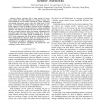1234 search results - page 131 / 247 » Adaptive Groupware for Wireless Networks |
GLOBECOM
2007
IEEE
14 years 3 months ago
2007
IEEE
— In wireless communications, shadow fading can cause at least 6 dB power loss for 10% of the time [1]. Early detection of shadow fading plays an important part in facilitating t...
GLOBECOM
2008
IEEE
13 years 10 months ago
2008
IEEE
—The proliferation of wireless systems requires that the coexistence between heterogeneous technologies be addressed. This paper presents a cognitive framework in which sensingba...
IPSN
2004
Springer
14 years 2 months ago
2004
Springer
Recent advances in technology have made low cost, low power wireless sensors a reality. Clock synchronization is an important service in any distributed system, including sensor n...
ICDCSW
2009
IEEE
14 years 3 months ago
2009
IEEE
—The number of active nodes in a WSN deployment governs both the longevity of the network and the accuracy of applications using the network’s data. As node hibernation techniq...
VTC
2008
IEEE
14 years 3 months ago
2008
IEEE
— Sensor networks with a large amount of sensor nodes usually have high redundancy in sensing coverage. The network lifetime can be further extended by proper scheduling and putt...

